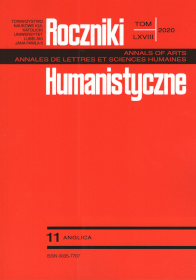Foreign-Space Dramatization in Graham Greene’s The Power and the Glory: Revisiting Greeneland
Abstract
Graham Greene was a frequent traveler and he commonly chose different spaces around the world as settings for his novels. Critics have generally agreed, however, that the British author created in his novels an a-topos, a space that conformed not to the reality of the country depicted, but to the development of the topics, spiritual or political, with which Greene was obsessed. That atopical location became over time what has been called Greeneland, a concept with which any Greene scholar inevitably becomes familiar. In this paper, I revisit the concept of Greeneland, arguing that scholars tend to focus on the major themes present in Greene’s literary world and to ignore the fact that a close analysis of the fictional landscape in his work challenges the assertion that what Greene created in his novels was a mental entity, a non-place. In order to do so, I focus on the representation of space and society in Greene’s The Power and the Glory (1940), the Mexico of the religious persecution of the late 1920s. I compare Greene’s representation with the Mexico of the same period depicted in Juan Rulfo’s Pedro Páramo (1955), a novel whose fictional landscape bears uncanny resemblances to the one described in The Power and the Glory. This analysis leads us to rethink the concept of Greeneland as generally defined in the criticism.
References
Bosco, Mark. Graham Greene’s Catholic Imagination. Oxford UP, 2005.
Brotherson, Gordon. “Provincia de almas muertas.” Fell, pp. 808–13.
Diephouse, Daniel. “The Allusiveness of Space in Graham Greene’s Novels.”
Perceptions of Religious Faith in the Work of Graham Greene, edited by Thomas Hill, Peter Lang, 2002.
Duffy, Charles F. “Ireland and Greeneland: The Irish in the Writings of Graham Greene.” Éire Ireland, vol. 30, no. 3, 1995, pp. 14–26.
Fell, Claude, editor. Juan Rulfo: Toda la obra. Critical Edition, Consejo Superior de Investigaciones Científicas, 1992.
Franklin, Ruth. “God in the Details. Graham Greene’s religious realism.” New Yorker, 4 Oct. 2004, www.newyorker.com/magazine/2004/10/04/god-in-the-details. Accessed 10 May 10, 2020.
Escalante, Evodio. “Texto histórico y texto social en la obra de Rulfo.” Fell, pp. 561–81.
Greene, Graham. The Power and the Glory. Penguin Books, 1971.
Escalante, Evodio. Ways of Escape. Penguin, 1981.
González Boixo, José Carlos. “Lectura temática de la obra de Juan Rulfo.” Fell, pp. 549–60.
Lanning, Carmen Nadine. The Ambiente of Five Latin American Novels by Graham Greene. Michigan: UMI, 1986.
Link, Christopher A. “Bad Priest and the Valor of Pity. Shusaku Endo and Graham Greene on the Paradoxes of Christian Virtue.” Logos, vol. 4, no. 4, 2012, pp. 75–96.
Martín Salván, Paula. The Language of Ethics and Community in Graham Greene’s Fiction. Palgrave Macmillan, 2015.
McEwan, Neil. Graham Greene. Macmillan, 1988.
Mudford, Peter. Graham Greene. Northcode House, 1996.
Pearson, Sheryl. “‘Is There Anybody There?’ Graham Greene in Mexico.” Journal of Modern Literature, vol. 9, no. 2, 1982, pp. 277–90.
Pozas, Ricardo. Juan Pérez Jolote. México: Fondo de Cultura Económica, 1952.
Rodríguez, Manuel. “El México de Juan Rulfo.” Cuadernos cervantinos de la lengua española, vol. 2, 1955, pp. 88–93.
Rodríguez Monegal, Emir. “Relectura de Pedro Páramo.” Fell, pp. 744–51.
Rulfo, Juan. Pedro Páramo. Grove Press, 1994.
Russel Rourke, Brian. Mexicos of the Mind: British Writers of the 1930s in Mexico. Michigan: UMI, 1999.
Sinyard, Neil. Graham Greene. A Literary Life. Palgrave Macmillan, 2003.
Watts, Cedric. “Janiform Greene: The paradoxes and pleasures of ‘The Power and the Glory’.” Dangerous edges of Graham Greene: journeys with saints and sinners, edited by Dermot Gilvary and Darren J. N. Middleton, Continuum, 2011, pp. 97–112.
Watts, Cedric. “Darkest Greeneland: Brighton Rock.” Graham Greene Studies, vol. 1, 2017, pp. 133–44.
Copyright (c) 2020 Roczniki Humanistyczne

This work is licensed under a Creative Commons Attribution-NonCommercial-NoDerivatives 4.0 International License.





